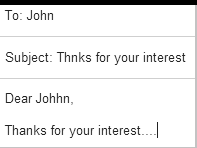More and more real estate marketing activities are rightly focused on the most important aspect of the agent-client relationship: effective communication. As a result, email continues to be an extremely important tool in every agent’s arsenal. After all, there’s really no other method for efficiently communicating with so many leads and clients at such a low cost. As the real estate email marketing landscape continues to expand, it becomes that much more important to focus on differentiating yourself as a top-tier agent. Part of that process is to ensure that you’re not making any ‘rookie’ mistakes that are sure to paint you as a ‘rookie agent’.

At Zurple, we encourage our agents to get the most out of their email strategy. Still, there are a number of mistakes that are both avoidable yet stubbornly persistent across the industry. So, the next time you compose an email to your prospective or current client, be cognizant to avoid the all-too-common mistakes below.
- Typos -It’s funny how some would suggest purposely sending typos in an email to make it seem less robotic or automated. A better way to avoid coming across like a robot is to make your emails personal with relevant information your recipient would appreciate. Take the 30 seconds to review an important email before it’s sent!
- Poor grammar - Make sure your sentences are coherent and in the proper tense. Although not everyone notices grammatical errors, glaring issues with your grammar may put off a prospective client – calling into question your professionalism in the process.
- Wrong property link - When sending out a link, make sure you send the right link. Sending clients, whose price range is $500k - $700k, a link to a $1.5 million home may be enough to have your future emails flagged as spam.
- Links don’t work - If you send an email with a link, make sure it works. Sometimes email editors will do some funky things with your URL - like add in an extra ‘http://’ so always be wary. Take the 10 seconds to click on your own link – there’s no excuse not to!
- Wrong property address - This is another easy one, but a big one. Always double-check addresses in emails targeting a specific property.
- Personalization is incorrect - Email tags can be dangerous, because they can be wrong. Go the extra mile by keeping your data clean to ensure that personalization tags are accurate (and don’t contain typos). After all, “Dear Johhn” doesn’t look so good...

- Date and/or time mix up - When sending out emails with dates and times, such as an open house announcement, be sure to triple check this information. A mistake here can result in some very frustrated people or even a loss of business. Remember, there’s no guarantee that someone will read your follow-up email correcting your prior mistake.
- Misleading 'from name' - If you’re using an email service like Mailchimp or Constant Contact, take extra care to ensure that the ‘from’ field uses a description that would be recognized by your audience (like, your name!). Otherwise, you can really hurt your open rates because people don’t know that it’s you who is sending the emails. Your personal brand is being used whenever people see the ‘from-name’ so make sure to get it right every time.
- Sending to the wrong recipients - Sending information to the wrong person or group of people is a great way to ask people to unsubscribe from your list. So, it goes without saying that your recipient list needs to be accurate, every time.
- Incomplete text - There are going to be instances when you’re writing an email, are interrupted, then finish composing that email at some later time. Except, you sent the email without realizing that you had a sentence that was just hanging or disjointed. As with typo avoidance, take an extra 30 seconds for a re-read, especially after an interruption.
- Correct pronouns based on context - If you’re sending an email blast – aimed at the individual - make sure your email references the individual as an individual. The same rule applies if you’re writing to a plural audience. Here’s an example:
‘I was thinking you might really like this property’…
instead of ‘I was thinking you all might like this property...’ - Missing intro - This may depend on your style & relationship with the recipient, but typically a greeting like hello, hey, or hi {first_name} is a nice thing to have at the very beginning of an email. While not a hard-and-fast rule, a missing intro can decrease the personal feel of an email.
To help you out, we’ve created a quick, printer-friendly checklist you can use for your own real estate email marketing campaigns - or even your personal emails. Download and print it by following the link below!



